Waters lab
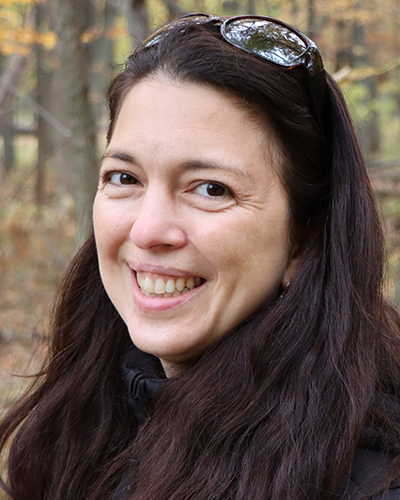
Dr. Lauren Waters
Associate Professor, Biochemistry
Information
Chemistry Department
University of Wisconsin Oshkosh
800 Algoma Blvd, Oshkosh WI 54901
Oshkosh Campus, Halsey 409
watersl@uwosh.edu
(920) 424-7099
Curriculum Vitae
Bibliography
Also including DOI 10.1101/2023.06.02.543501
Courses Taught
Biochemistry: Clinical Emphasis
Advanced Biochemistry
Biochemistry Lab
General Chemistry I and II (Laboratory and Discussion)
Research
I am interested in the molecular and biochemical ways that bacteria sense, respond, and adapt to stress conditions. Specifically, in my lab we are studying the regulation, binding interactions, and physiological function of proteins involved in manganese homeostasis. One of these is a member of the intriguing and understudied class of small proteins (< 50 amino acids), which are thought to bind and regulate larger proteins during in stress responses. Fundamental aspects of small proteins, such as their molecular mechanism of action, downregulation after they are no longer needed, and their evolutionary origin are poorly understood.
Manganese is an essential micro-nutrient for organisms from bacteria to humans. It is a cofactor for critical enzymes and helps detoxify reactive oxygen species (ROS). Manganese is required by photosynthetic organisms, since it is a part of the water-splitting complex in Photosystem II. Manganese is also critical for many pathogenic and symbiotic bacteria in order to survive in eukaryotic host tissues. For example, Salmonella needs manganese to infect human macrophages, Staphylococcus and Streptococcus pathogens require manganese to survive in abscesses, and the nitrogen-fixing plant symbiont Rhizobium uses manganese to live inside alfalfa root nodules. Yet in excess, manganese is toxic. In humans, manganese over-exposure can lead to neurodegeneration. In bacteria, excessive manganese likely causes imbalanced metal pools in cells that affect enzyme function.
In my lab, we are investigating the small protein, MntS, and a manganese exporter, MntP. We have found the MntS binds to MntP and inhibits its manganese export activity. MntS also binds to itself in cells in a manganese-specific manner. We are using biochemical and biophysical approaches to purify MntS and examine its binding to various metals and to other proteins in vitro.
Intriguingly, we also discovered that MntS is homologous to the signal peptide region of of another protein, SitA. SitA is the periplasmic metal-binding subunit of a manganese importer. Remarkably, the homologous signal peptide regions can substitute for MntS in vivo demonstrating a functional relationship between MntS and these signal peptides. Moreover, our data shows these "functional signal peptides" have an additional role in manganese homeostasis, beyond their cannonical role in protein secretion. As bioinformatic data also shows a conserved pattern of gene neighborhoods for MntS and related SitA proteins across genomes, we hypothesize that MntS originally emerged as a stand-alone gene by breaking off from the intact SitA protein in an ancestral bacterial species.
Previously in the lab, we characterized the structure and function of the MntP manganese efflux protein. We performed computational analysis of the sequence, including multiple sequence alignments and membrane topology predictions, to identify highly conserved, putative metal-binding amino acids to mutate. MntP mutants were tested for activity using a manganese toxicity growth assay and sensitivity to reactive oxygen species.
Any interested students, please email to find out about research opportunities in the lab! watersl@uwosh.edu
Student Presentation Pictures
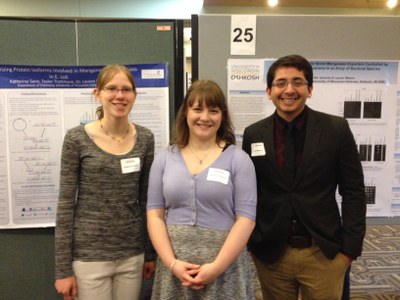
Kathy Senn, Jen Schmitz, Eli Martinez at the UW Oshkosh Celebration of Scholarship 2016
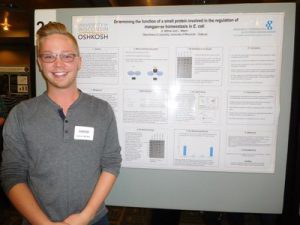
Nathan Witman at the UW Oshkosh Celebration of Scholarship 2018
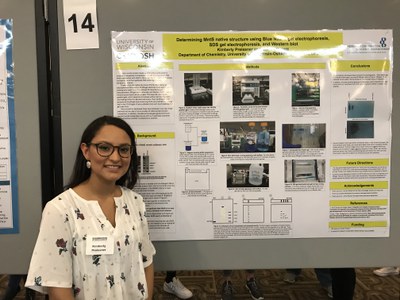
Kimberly Preissner at the UW Oshkosh Celebration of Scholarship 2019
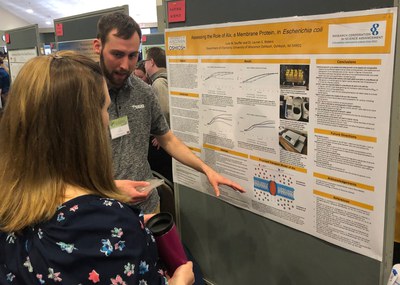
Luke Seuffer at the UW Oshkosh Celebration of Scholarship 2019

Mackenzie Seymour, Zac Wright at the ASBMB National Meeting in Philadelphia 2022

Maggie Gosz, Lindsay Goeden at the UW Oshkosh Celebration of Scholarship 2023
Other Lab Pictures

Elias Flor Martinez, Doua Xiong in the lab 2020
